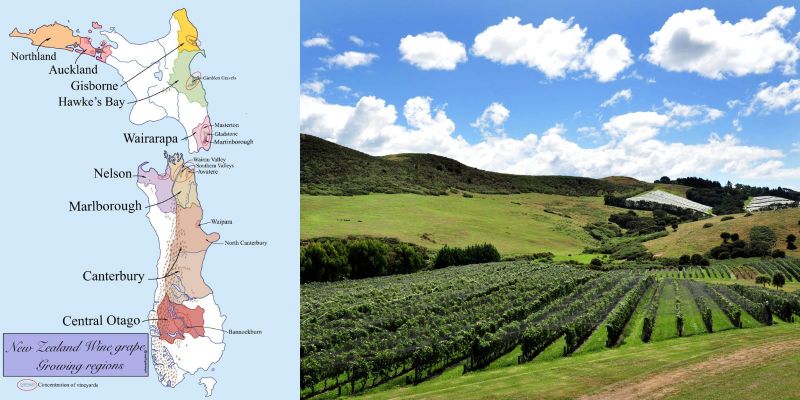Educating Sommeliers Worldwide.
By Beverage Trade Network

Sommelier Business collaborates with Nicolas Quillé, MW, to produce a concise wine technical series aimed at providing on-trade professionals with essential wine technical knowledge. In this article, we explore the diverse and vibrant wines of New Zealand.
New Zealand stands out as one of the coolest climate wine-producing countries outside Europe among the top 20 wine producers. The nation primarily enjoys a maritime climate, with Central Otago offering the unique distinction of a continental climate. Most vineyards are situated on the east side of the islands, shielded from the tumultuous Tasman Sea. The country is divided into two main islands—North and South—with several key wine regions.
Auckland Region:
The proximity to New Zealand’s largest city, Auckland, which is home to a third of the country's 5.1 million population, makes it an ideal location for a tourism-based wine industry despite the region's warmer and more humid climate. Waiheke Island exemplifies this tourism-centric industry. Kumeu, particularly known for the Kumeu River winery, is famous for its benchmark wines.
Gisborne:
A warm and wet region, Gisborne specializes in white grapes, producing excellent Pinot Gris and Chardonnay.
Hawke’s Bay:
Home to 75% of the North Island's grape plantings, Hawke’s Bay is renowned for its Bordeaux varieties thriving in well-drained alluvial soils, such as those found in the esteemed Gimblett Gravels area. The region is also noted for its distinctive Syrah wines.
Wairarapa:
Originally a premium region for Pinot Noir, driven by investments in Martinborough and its proximity to Wellington, the country's capital. Pinot Noir wines from boutique wineries here tend to be more earthy and structured compared to their Central Otago counterparts.
Nelson:
An emerging cool and rainy region with significant potential, Nelson is mainly planted with Sauvignon Blanc.
Marlborough:
The powerhouse of New Zealand wine, Marlborough accounts for 71% of all vineyard plantings, focusing primarily on Sauvignon Blanc. This region is further divided into three sub-regions:
- The Wairau Valley: Warm with cool nights, producing riper styles of Sauvignon Blanc.
- The Southern Valleys: The smallest sub-region with heavier clay soils that delay ripening.
- The Awatere Valley: Cool and windy, leading to a greener style of Sauvignon Blanc.
Canterbury:
Often overlooked, Canterbury is a cool region centered on Waipara in North Canterbury. Known for its Pinot Noir, the region also produces noteworthy Riesling wines.
Central Otago:
The only continental climate region in the country, located in the rain shadow of the Southern Alps, making it a dry area. Central Otago focuses on producing ripe and vibrant Pinot Noir, contrasting starkly with Martinborough. The region has several sub-regions, with Bannockburn often appearing on labels.
New Zealand has 21 Geographical Indications (GIs) that may be applied to wine labels, although non-GI locations, like Awatere Valley, are also common. The purity standard for labeling is 85% across the board—whether for vintage, grape variety, or designation of origin. Kiwis have a strong commitment to sustainability, with the “Sustainable New Zealand” certification program covering 96% of their vineyards.
This wraps up a quick overview of New Zealand, a dynamic and export-oriented cool climate wine producer. The country's unique climates, diverse regions, and strong focus on sustainability make it a standout player in the global wine industry. Cheers to discovering the vibrant wines of New Zealand!

Born in Lyon, France, from a family in the wine business for three generations. Nicolas has a Master degree in winemaking from the University of Dijon, Burgundy and a Master in sparkling winery management from the University of Reims, Champagne. Prior to coming to the United States, have worked in Burgundy and the Rhone Valley as a winemaker.
He came to the United States in 1997 and worked for J. Lohr and The Hogue Cellars as a winemaker. During his time at Hogue Cellars, he went back to school and earned a MBA with honors from the University of Washington (first of class). He was the General Manager and Winemaker for Pacific Rim for 10 years where I lead our two wineries making 600,000 cases of wine. He recently took a position as the Chief Winemaking and Operations Officer for the Crimson Wine Group supervising six prestigious estate wineries in OR, WA and CA. In 2018 he became a Master of Wine formerly joining the prestigious Institute of Masters of Wine.